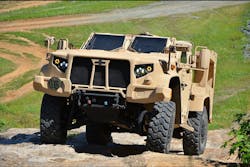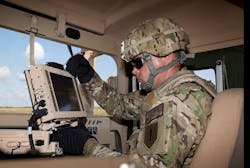Leonardo DRS vetronics rugged computers declared standard gear on the Joint Light Tactical Vehicle (JLTV)
WARREN, Mich. – U.S. Army vetronics experts have declared a common family of rugged vehicle-mount computers from the Leonardo DRS Land Electronics business unit in Melbourne, Fla., to be standard equipment on the Joint Light Tactical Vehicle (JLTV) for the Army and U.S. Marine Corps.
Officials of the Army Contracting Command-Detroit Arsenal in Warren, Mich., announced a $14.5 million order to JLTV maker Oshkosh Defense LLC in Oshkosh, Wis., to make the Leonardo DRS Mounted Family of Computer Systems (MFoCS) II part of the JLTV's baseline configuration.
A baseline configuration describes the standard version of a military weapons system like the JLTV, and helps describe how and when the system will be upgraded or otherwise change.
The MFoCS II consists of dismountable tablet computers, platform-computing servers, docking stations, interconnecting cables, installation kits, and three sizes of ruggedized sunlight-readable, touch-screen display units. This family of rugged vetronics computers is for more than 40 types of ground vehicles and weapons.
The MFoCS II family of systems supports fielding and upgrades of the Army's Joint Battle Command-Platform (JBC-P) and features systems upgrades, cyber security, and multi-touch displays.
A critical component of the MFoCS II system is the cyber-hardening technology inside the hardware called Edge-Assured that ensures that commanders are operating protected and trusted computing systems.
MFoCS II also retains components from the first-generation MFoCS, including a dismountable tablet, an expandable rugged computer, and 12-, 15-, and 17-inch sunlight-readable rugged displays with multi-touch functionality.
Related: Oshkosh chooses Telephonics NetCom vetronics communications system for JLTV program
MFoCS integrates the Army's Force XXI Battle Command Brigade-and-Below (FBCB2) and JBC-P capabilities into a common computing system. It supports situational awareness, command and control, and maneuver capability with next-generation rugged computers and displays at several different configurable levels. Systems include ruggedized tablets, processors, keyboards, removable solid-state disks, displays, and cabling.
JBC-P consists of ultra-rugged computers, software, and Suite B encryption security that enables warfighters to send and receive friendly force position location.
JBC-P essentially is a follow-on to, or advanced component of, the Army's FBCB2 program, and is interoperable with the current FBCB2 Blue Force Tracking (BFT) system.
The FBCB2 provides battlefield situational awareness to enable fast, well-informed decisions. The JBC-P is expected to enhance FBCB2 performance, and reduce the risk of fratricide.
Related: Oshkosh Defense chooses vetronics solid-state power controllers from DDC for military JLTV
MFoCS II complies with the Army's Vehicular Integration for C4ISR/EW Interoperability (VICTORY) standards initiative. The Army awarded the original MFoCS contract to DRS in 2013 in a potential $455 million deal. The contract called for DRS to build a variety of vehicle-mounted command, control, communications, computers, intelligence, surveillance, and reconnaissance (C4ISR) equipment.
The foundational element of the MFoCS program is the rugged tablet that warfighters can mount in combat vehicles, as well as disconnect the tablets and continue using them while operating on foot. This enables warfighters in vehicles to share what they are seeing on their screens with warfighters operating on foot. Battlefield commanders can work on a tablet in a combat vehicle, and then take the computer into a command post and dock it.
On this order Oshkosh will do the work in Oshkosh, Wis., and should be finished by June 2021. For more information contact Oshkosh Defense online at https://oshkoshdefense.com, Leonardo DRS Land Electronics at www.leonardodrs.com, or the Army Contracting Command-Detroit Arsenal at https://home.army.mil/detroit/index.php/units-tenants/acc-warren.

